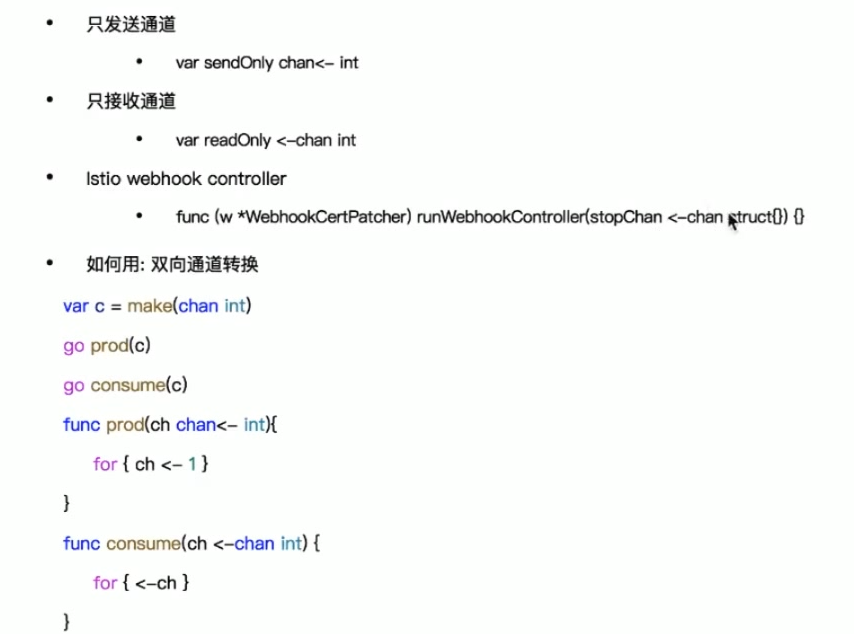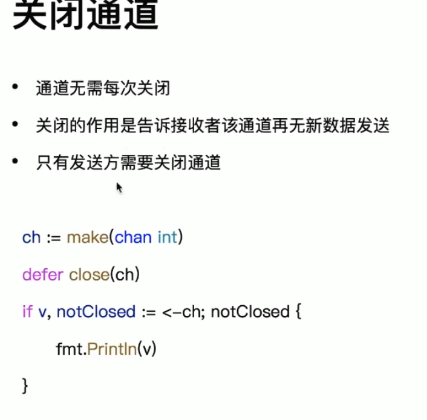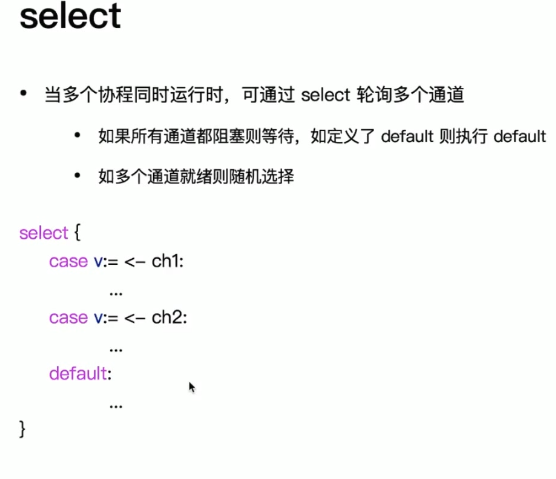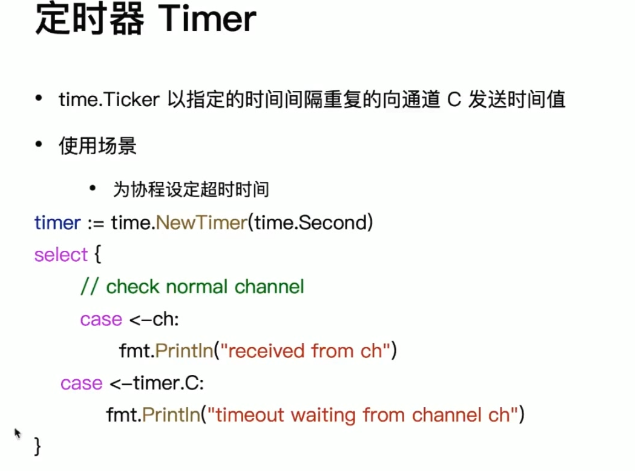channel
创建 channel
1
|
msg := make(chan int, 10)
|
- 基于 channel的通信是同步的
- 当缓冲区满时,数据发送是阻塞的
- 通过 make 关键字创建通道时候可以定义缓冲区容量,默认缓冲区容量为0
单向通道

避免生产者 用了消费通道,单向通道可以做限制
关闭通道

轮询多个通道
我需要同时处理多个通道,处理对应的逻辑

定时器 Timer

1
2
3
4
5
6
|
timer1 := time.NewTimer(time.Second * 2)
t1 := time.Now()
fmt.Printf("t1:%v\n", t1)
t2 := <-timer1.C
fmt.Printf("t2:%v\n", t2)
|
context 原理
1
2
3
4
5
6
|
type Context interface {
Deadline() (deadline time.Time, ok bool)
Done() <-chan struct{}
Err() error
Value(key interface{}) interface{}
}
|
Context的使用最多的地方就是在Golang的web开发中,在http包的Server中,每一个请求在都有一个对应的goroutine去处理。请求处理函数通常会启动额外的goroutine用来访问后端服务,比如数据库和RPC服务。用来处理一个请求的goroutine通常需要访问一些与请求特定的数据,比如终端用户的身份认证信息、验证相关的token、请求的截止时间。 当一个请求被取消或超时时,所有用来处理该请求的 goroutine都应该迅速退出,然后系统才能释放这些goroutine占用的资源。虽然我们不能从外部杀死某个goroutine,所以我就得让它自己结束,之前我们用channel+select的方式,来解决这个问题,但是有些场景实现起来比较麻烦,例如由一个请求衍生出的各个 goroutine之间需要满足一定的约束关系,以实现一些诸如有效期,中止goroutine树,传递请求全局变量之类的功能。
保存上下文
我们可以在上下文中保存任何的类型的数据,用于在整个请求的生命周期去传递使用。
1
2
3
4
5
6
7
8
9
10
11
12
13
14
15
16
17
|
func middleWare(next http.Handler) http.Handler {
return http.HandlerFunc(func(w http.ResponseWriter, req *http.Request) {
ctx := context.WithValue(req.Context(),"key","value")
next.ServeHTTP(w, req.WithContext(ctx))
})
}
func handler(w http.ResponseWriter, req *http.Request) {
value := req.Context().Value("value").(string)
fmt.Fprintln(w, "value: ", value)
return
}
func main() {
http.Handle("/", middleWare(http.HandlerFunc(handler)))
http.ListenAndServe(":8080", nil)
}
|
超时控制
这里用一个timerCtx来控制一个函数的执行时间,如果超过了这个时间,就会被迫中断,这样就可以控制一些时间比较长的操作,例如io,RPC调用等等。
1
2
3
4
5
6
7
8
9
10
11
12
13
14
15
16
17
18
19
20
21
22
23
24
25
26
27
28
|
func longRunningCalculation(timeCost int)chan string{
result:=make(chan string)
go func (){
time.Sleep(time.Second*(time.Duration(timeCost)))
result<-"Done"
}()
return result
}
func jobWithTimeoutHandler(w http.ResponseWriter, r * http.Request){
ctx,cancel := context.WithTimeout(context.Background(), 3*time.Second)
defer cancel()
select{
case <-ctx.Done():
log.Println(ctx.Err())
return
case result:=<-longRunningCalculation(5):
io.WriteString(w,result)
}
return
}
func main() {
http.Handle("/", jobWithTimeoutHandler)
http.ListenAndServe(":8080", nil)
}
|




